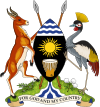Main economic focus
Agriculture is Uganda's main economic activity. Twelve key agricultural products have been earmarked for investment: cotton, coffee, tea, maize, rice, cassava, beans, fish, beef, milk, citrus and bananas. On food security, Uganda scores a rate of 78.2 compared to what is possible at its rate of income. [14]
Uganda is commonly referred to as the pearl of Africa [15] [16] because of its natural beauty. This often attracts tourists from all over the world. Improvement, diversification and aggressive marketing of the tourism sector has thence been highlighted in the second national development plan. The country will focus on the exploitation of iron ore, limestone ad marble, copper, cobalt, phosphates, dimension stones and uranium. In addition, the country's newly discovered 6.5 billion barrels of oil are to be exploited.
Right to Work and to earn an adequate income in Uganda
According to international law, everyone is entitled to the opportunity to gain a living by work that is freely chosen and "the right to the enjoyment of just and favourable conditions of work". This includes "equal pay for equal work, the chance to earn a decent living for [ourselves] and [our] families, just and safe working conditions, and a reasonable limitation of working hours" (ICESCR, Articles 6 and 7). The Rights Tracker scores Uganda at 39.1%. [17] This right is measured using indicators such as the number of people above the relative poverty line, the number of people, the number of people above absolute poverty and the number of unemployed people. [18]

